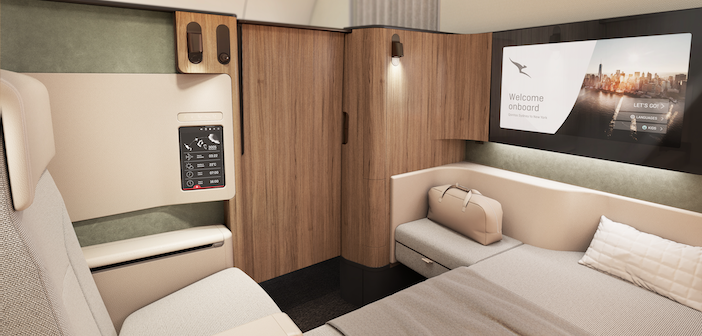Qantas Unveils A350 “Project Sunrise” First and Business Class Designs

Following the reveal of the preliminary designs for its A350-1000 ultra-long-haul premium cabins last year, Qantas has now unveiled prototypes of the first and business-class cabins. The Australian airline ordered 12 Airbus A350-1000 aircraft in May 2022, which will begin flying passengers non-stop from Australia to New York and London from late 2025.
These point-to-point flights are expected to cut total travel time by up to four hours compared with the current one-stop flights, but this means passengers will be spending up to 20 hours in the aircraft. The time saving is valuable, but onboard comfort will be even more critical. Enter Project Sunrise…
The proposition begins with the seat count, which is planned to be 238 – the lowest of any A350-1000 currently in service, enabling more passenger space in the cabins and also reducing aircraft weight to maximise range to 8,700nm (16,100km) and enable an extra fuel tank to be added. By comparison, the A350-1000 can accommodate up to 480 passengers, with current operator seat counts including Qatar Airways (327 seats), British Airways (331 seats), Cathay Pacific (334 seats) and Virgin Atlantic (335 seats).
Qantas then collaborated with aviation specialists, industrial designers (the Caon Design studio in Sydney), and a multidisciplinary team of scientists (including sleep scientists) from the University of Sydney’s Charles Perkins Centre.
All cabins have been reconsidered for the ultra-long-haul travel experience, with the Wellbeing Zone (a movement and refreshments space), the 40-seat (2-4-2) Premium Economy cabin and 140-seat (3-3-3) Economy cabins due to be revealed in the coming months. The flagship cabins, key to the commercial success of long routes with a low seat count, are the first to be revealed.
Private First and business suites
The six spacious First suites (50% larger than Qantas’ A380 first class), configured 1-1-1, have been designed to feel like mini boutique hotel rooms, enclosed within 57in (1.4m)-high walls with sliding doors. Each suite will feature an 80in (2m)-long ‘extra-wide’ fixed bed, a separate 22in-wide reclining armchair, a full-length personal wardrobe, a table large enough for two people to work or dine together) and a 32in ultra-high definition TV (14in larger than in A380 first class). There is even an adjustable bed backrest for a comfortable breakfast in bed.
Each of the 52 Business suites is 42in-wide, enclosed by 47in-high walls with a sliding door, and the 1-2-1 layout gives direct aisle access. Within those walls will lie a 25in-wide seat that converts to an 80in (2m)-long bed (actually 1in longer than Qantas’ A380 first-class beds), generous storage space (including a large mirror and upholstered glove box), a cushioned leather ottoman, a large dining table and feature lighting. The 18in ultra-high definition touchscreen IFE monitor will be 2in larger than those found in Qantas’ A380 and B787 business class.
Both First and Business will offer multiple personal device charging options, including USB-A and C, AC and wireless induction charging outlets.
Meanwhile all 238 passengers on board can access fast and free high-speed cabin wi-fi, provided by partner Viasat following completion of key satellite launches covering the Qantas international network. All seats will also feature Bluetooth connectivity, allowing all customers to connect their own Bluetooth-enabled headset to the in-flight entertainment system.
To get a feel for the spaces, try out this virtual reality flythrough video of the aircraft cabins.
“We began designing this aircraft cabin five years ago, working with Airbus and Qantas to maximise space, as well as creating a tailored lighting programme that will influence mood and sleep patterns,” said David Caon, founder of Caon Design, who co-created the A350 interiors.
“All the design and service elements will work together to significantly improve inflight comfort, convenience and health and wellbeing, and help minimise the old nemesis of jetlag. Every element has been created for Qantas, from the reading light right down to the fabrics, to ensure that passengers spend their journey in refined comfort.”
“There are also a number of storage design elements to keep personal items within arm’s reach so the space can be personalised by each individual passenger to feel just like they are in their own bed at home,” Caon added.
Another comfort that passengers will enjoy is inflight catering designed by Australian star chef Neil Perry, Qantas’ director of food, beverage and service.
Qantas Group CEO Alan Joyce said of the investment in the new A350-1000s: “Qantas has been the leader in opening up new long-haul flights for most of our history, and we’re bringing everything we’ve learned, both technically and in terms of passenger comfort, to Project Sunrise flying.”
“We think our A350 cabins have the most sophisticated and thoughtful design of any airline, combining cutting-edge technology with sleep research to shape the look and feel for what is effectively a new era of travel.”
Air New Zealand has also been busy designing experiences for the ultra-long-haul routes enabled by its B787-9s. We interviewed Kerry Reeves, the airline’s head of airline programmes, to find out more about their innovative designs – the article is available HERE.
